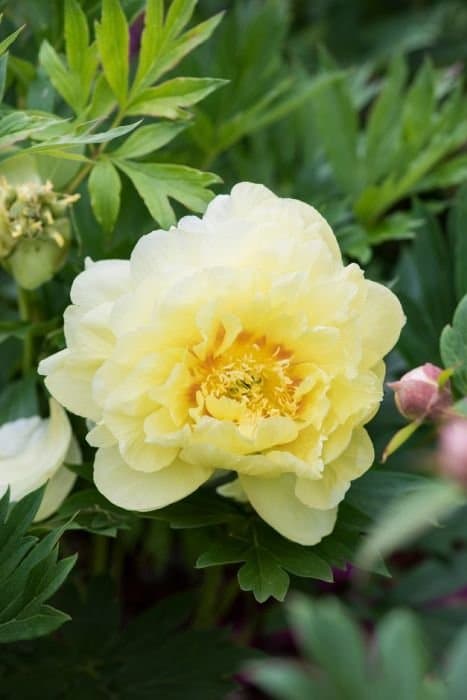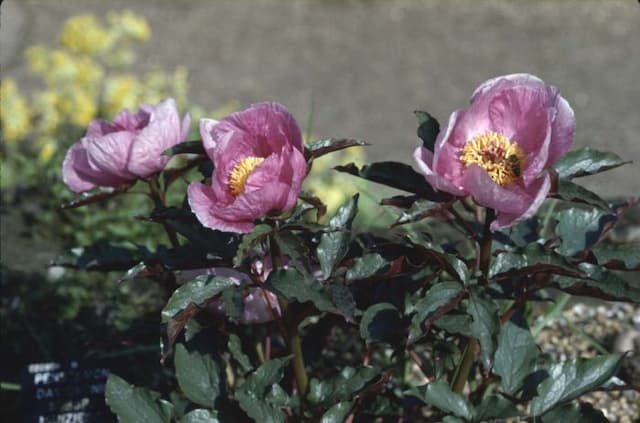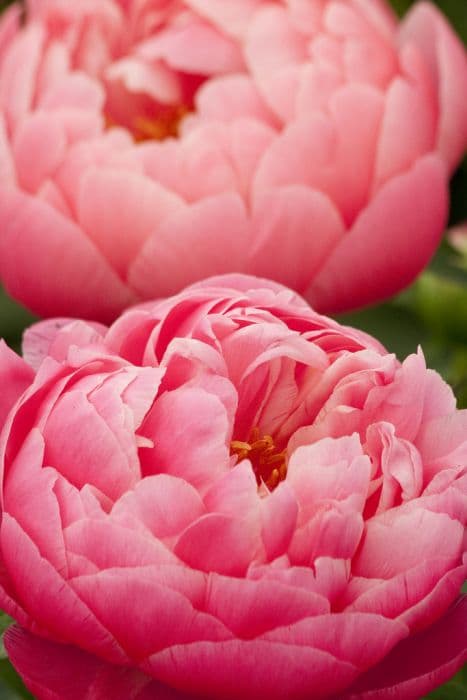Peony Paeonia lactiflora 'Serene Pastel'

ABOUT
The plant known as Paeonia lactiflora 'Serene Pastel', commonly referred to as the Chinese peony, is adorned with an exquisite display of soft, pastel-colored flowers. The blooms exhibit a delicate blend of creamy shades that can include pale pink, blush, peach, or a soft yellow hue, often with a subtle transition of colors that gives each flower a serene, dreamlike quality. The petals of the Chinese peony 'Serene Pastel' are subtly ruffled and gracefully arranged in a dense, rounded form that exudes a classic, refined elegance. At the center of the flowers, a cluster of golden-yellow stamens provides a captivating contrast to the gentle pastels, drawing the eye and highlighting the intricate beauty of the bloom. These flowers are borne atop strong, upright stems that are cloaked in deep green, glossy leaves. The foliage forms an attractive backdrop to the flowers, with each leaf boasting a broad, lance-shaped outline that tapers to a point. The leaves may also display a slight undulation along their edges, adding visual interest even when the plant is not in bloom. Overall, the Chinese peony 'Serene Pastel' presents a lush, full-bodied floral display that is both enchanting and serene, evoking a sense of tranquility and classic beauty in any garden setting.
About this plant
 Names
NamesFamily
Paeoniaceae
Synonyms
Chinese Peony, Common Garden Peony
Common names
Paeonia lactiflora.
 Toxicity
ToxicityTo humans
Peonies, such as the Paeonia lactiflora 'Serene Pastel', are not considered highly toxic to humans. However, ingesting peonies can cause mild gastrointestinal discomfort, including nausea and diarrhea. It is always wise to discourage children from eating any parts of ornamental plants due to the potential for mild stomach upset.
To pets
Peonies, including varieties like Paeonia lactiflora 'Serene Pastel', are considered potentially toxic to dogs and cats. If a pet ingests part of a peony, they may experience gastrointestinal upset, including vomiting and diarrhea. In most cases, the symptoms are mild, but it is still recommended to keep these plants out of reach of pets and to contact a veterinarian if any significant amount of the plant is consumed.
 Characteristics
CharacteristicsLife cycle
Perennials
Foliage type
Deciduous
Color of leaves
Green
Flower color
Pink
Height
2-3 feet (0.6-0.9 meters)
Spread
2-3 feet (0.6-0.9 meters)
Plant type
Herb
Hardiness zones
3-8
Native area
Asia
Benefits
 General Benefits
General Benefits- Aesthetic Appeal: The Paeonia lactiflora 'Serene Pastel', commonly known as Peony, offers a lush display of pastel-colored flowers, enhancing the beauty of any garden.
- Garden Design Versatility: Peonies can be used in a variety of garden designs, from borders to formal beds, adding structure and elegance.
- Attracts Pollinators: Peonies attract bees and other pollinators, contributing to the health of the garden ecosystem.
- Longevity: Peonies are known for their longevity, often living for decades and providing long-lasting value.
- Seasonal Interest: With a blooming season in late spring to early summer, Peonies provide a burst of color when many other plants are not yet in full bloom.
- Low Maintenance: Once established, Peonies require minimal maintenance beyond annual pruning and occasional feeding.
- Cut Flowers: The blooms of Peonies make excellent cut flowers, allowing for stunning indoor arrangements.
- Drought Tolerance: Peonies, once established, have moderate drought tolerance, making them suitable for gardens with less frequent watering regimes.
- Deer Resistance: Peonies are generally resistant to deer, preventing damage that can be caused by wildlife in the garden.
- Cold Hardy: Able to withstand cold winters, Peonies are suitable for growth in a range of climates with appropriate winter chilling.
 Medical Properties
Medical Properties- Anti-inflammatory: Contains compounds that may help reduce inflammation.
- Antioxidant: Possesses antioxidant properties that can help protect cells from damage.
- Immunomodulatory: Might influence immune system function and potentially modulate immune response.
- Analgesic: Traditional use suggests potential pain-relieving properties.
 Air-purifying Qualities
Air-purifying QualitiesThis plant is not specifically known for air purifying qualities.
 Other Uses
Other Uses- Cut Flowers: Paeonia lactiflora's large, showy blooms are often used in floral arrangements and can last more than a week when cut and properly cared for.
- Garden Design: Gardening enthusiasts use these plants in borders, as specimen plants, or in mass plantings to create a serene, pastel-themed garden space.
- Wedding Decorations: The soft pastel flowers are popular in wedding bouquets and centerpieces, contributing to a romantic and elegant ambiance.
- Educational Study: Botany students and horticulturists may study Paeonia lactiflora to understand plant growth patterns, propagation, and breeding.
- Artistic Inspiration: Artists and photographers often use these graceful blooms as subjects for their work due to their delicate appearance and soothing colors.
- Culinary Presentation: Although not edible, the petals can be used for ornamental garnish on special dishes for added aesthetic appeal.
- Crafting: Dried petals of Paeonia lactiflora can be incorporated into various crafts, such as handmade paper or potpourri.
- Symbolic Gift: Commonly known as the peony, these flowers symbolize prosperity and good fortune, making them an appropriate gift for new beginnings.
- Fragrance Extraction: While not a common practice, the flowers can potentially be used for extracting natural scents for perfumes or scented oils.
- Photography Studies: Due to their distinct layers and colors, peony flowers are useful in photography classes to teach depth of field and composition.
Interesting Facts
 Feng Shui
Feng ShuiThe peony is considered in Feng Shui to bring good fortune and a happy marriage. It is best placed in the southwest area of the garden or home to enhance love and romance.
 Zodiac Sign Compitability
Zodiac Sign CompitabilityThe peony is not used in astrology practice.
 Plant Symbolism
Plant Symbolism- Prosperity: The peony is often associated with wealth and success in life, making it a symbol of prosperity.
- Romance: With its full, soft blooms, the peony is considered a symbol of romantic love, often used in weddings and courtship.
- Honor and Nobility: In many cultures, peonies are connected to honor and high social status, representing nobility of character.
- Good Fortune: The lush beauty of the peony makes it a symbol of good luck and positive outcomes.
- Compassion: Some interpretations suggest peonies symbolize compassion, due to their full and rounded blooms which exude a soothing presence.
 Water
WaterPeonies, like the 'Serene Pastel', prefer to be watered deeply and infrequently to simulate natural rainfall. It’s crucial to allow the soil to dry out between waterings to prevent root rot. Typically, watering once every 10 to 14 days with about 1 gallon of water per plant is sufficient, depending on weather conditions. During periods of drought or extreme heat, you may need to water more frequently, but always check the soil moisture first. Avoid watering overhead which can lead to fungal diseases; instead, water at the base of the plant.
 Light
LightPeonies such as 'Serene Pastel' thrive in full sun to partial shade. They require at least six hours of sunlight a day to bloom well. However, in hotter regions, some afternoon shade is beneficial to prevent the blooms from fading too quickly. The best spot for the plant would be in an area that gets morning sunlight and some protection from the intense heat of the late afternoon sun.
 Temperature
TemperaturePeonies like 'Serene Pastel' are quite hardy and can tolerate a wide range of temperatures. They can survive winter temperatures as low as -20°F and summer temperatures up to 90°F. However, they prefer a temperate climate and bloom best when the spring temperatures are between 65°F and 75°F. It's worth noting that a period of winter chilling, below 40°F, is necessary for bud formation.
 Pruning
PruningPeonies like 'Serene Pastel' should be pruned to remove spent flowers and to keep the plant looking tidy. This also helps to prevent diseases by increasing air circulation. Cut back the foliage to the ground in the fall after it has been killed by frost to help control overwintering diseases and pests. Pruning is not typically necessary during the growing season unless you are removing dead or damaged wood.
 Cleaning
CleaningAs needed
 Soil
SoilPeony 'Serene Pastel' thrives in well-draining, fertile loam with compost incorporated. A slightly acidic to neutral pH of 6.5-7.0 is ideal.
 Repotting
RepottingPeonies like 'Serene Pastel' rarely need repotting; if necessary, do so in the fall, every 10-15 years.
 Humidity & Misting
Humidity & MistingPeony 'Serene Pastel' tolerates average outdoor humidity levels but does not require specific humidity adjustments.
 Suitable locations
Suitable locationsIndoor
Peony 'Serene Pastel' needs bright light indoors & cool temps to bloom.
Outdoor
Peony 'Serene Pastel' prefers sunny spot, shelter from strong winds.
Hardiness zone
3-8 USDA
 Life cycle
Life cyclePaeonia lactiflora 'Serene Pastel', commonly known as Chinese Peony 'Serene Pastel', typically starts as a dormant bare-root, planted in late fall to early winter. It enters a germination phase in early spring, developing shoots that emerge from the soil as temperatures rise. The plant grows and forms compound, deeply lobed leaves and strong stems, reaching up to 2-3 feet in height. In late spring to early summer, it produces large, fragrant flowers in a pastel color palette, after which the plant enters the bloom phase, attracting pollinators and potentially setting seeds if fertilization occurs. Post-blooming, the plant gradually begins to store energy in its root system as the foliage starts to die back in late summer to fall. The perennial rootstock overwinters dormantly, surviving the cold months to restart the cycle the following spring.
 Propogation
PropogationPropogation time
Spring-Early Summer
The most popular method of propagating the Paeonia lactiflora 'Serene Pastel', commonly known as the Chinese Peony, is by division. This process is best done in the fall, after the plant has gone dormant. To propagate by division, gardeners should carefully dig up the peony plant, taking care to minimize damage to the roots. The root ball should then be divided into sections, ensuring that each section has at least three to five eyes, which are the small reddish buds from which new shoots will grow. The divisions should be planted promptly, with the eyes positioned about 2 inches (approximately 5 centimeters) below the surface of the soil, allowing sufficient room for the new plants to grow. This method of propagation allows for the consistent quality of new plants that retain the characteristics of the 'Serene Pastel' variety.









